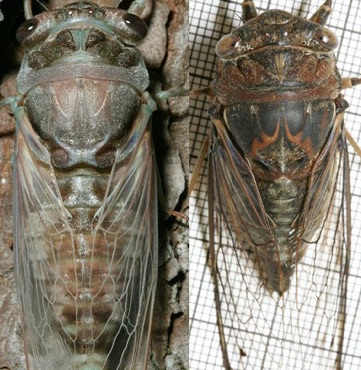Megatibicen resonans (Walker, 1850) aka Great Pine Barrens Cicada.

Photo by Joe Green.
See all Megatibicen resonans images & information on cicadamania.com.
Song type: Call
Source: ©Insect Singers | Species: M. resonans
Song type: Call
Source: ©Joe Green | Species: M. resonans
Video
Video Playlist
Playlists contain multiple videos found on YouTube.
Name, Location and Description
- Cicada Name: Megatibicen resonans (Walker, 1850)
- Short Name: M. resonans
- Common Name: Southern Resonant, Great Pine Barrens Cicada
- Synonym/Former Name: Tibicen resonans
- When: June-October. Peaks in August.
- Where it is found: AL, FL, GA, LA, MS, NC, SC, TN, TX, VA
- Maps: Biogeography of the Cicadas (Hemiptera: Cicadidae) of North America, North of Mexico [PDF]
- Description: Brown, black & white pruinosity distinctively present within curves of the cruciform elevation.
- Eye Color: brown
- Pronotal Collar Color: brown
- Identification: Bug Guide
- Identification: Bill Reynolds on iNaturalist
- Identification: iNaturalist
- Subject Matter Expert website: Cicada Central
- Taxonomic Information: Integrated Taxonomic Information System
- Song: Insect Singers
Key to Species by Wm. T. Davis from MISSISSIPPI CICADAS, WITH A KEY TO THE SPECIES OF THE SOUTHEASTERN UNITED STATES.1
A. Large, heavy bodied species ; head broad, uncus simple, and first cross vein in the fore wings starting from radius 3 far back, or about one third distant from base of first marginal cell.
BB. Uncus broad at the base, triangular in shape and generally about as broad as long. Opercula broad and rounded at the extremities no definite black area on the central part of the abdomen beneath, usually unicolorus.
E. Wings long and narrow, collar 2 mm. or less in breadth at central portions ; dorsum of abdomen black or nearly so.
Basal cell of fore wings rusty in color, anal cells (membranes) of both pair of wings gray; usually expands 110 mm. or more resonans (Walker).
Classification:
Family: Cicadidae
Subfamily: Cicadinae
Tribe: Cryptotympanini
Subtribe: Cryptotympanina
Genus: Megatibicen
Species: Megatibicen resonans (Walker, 1850)
List of sources
- Davis, W.T. 1918. MISSISSIPPI CICADAS, WITH A KEY TO THE SPECIES OF THE SOUTHEASTERN UNITED STATES. Journal of the New York Entomological Society, Vol. XXVI, Nos. 3-4. Read it on archive.org.
- Full Binomial Names: ITIS.gov
- Common names: BugGuide.net; The Songs of Insects by Lang Elliott and Wil Herschberger; personal memory.
- Locations: Biogeography of the Cicadas (Hemiptera: Cicadidae) of North America, North of Mexico by Allen F. Sanborn and Polly K. Phillips.
- Descriptions, Colors: personal observations from specimens or photos from many sources. Descriptions are not perfect, but may be helpful.
Notes:
- Some descriptions are based on aged specimens which have lost some or a lot of their color.
















